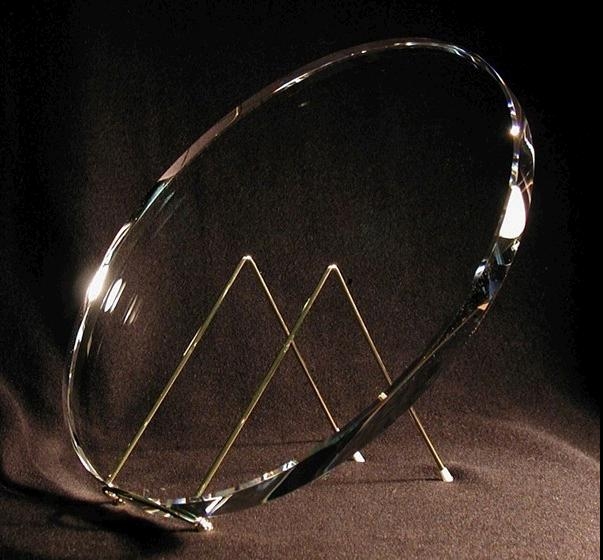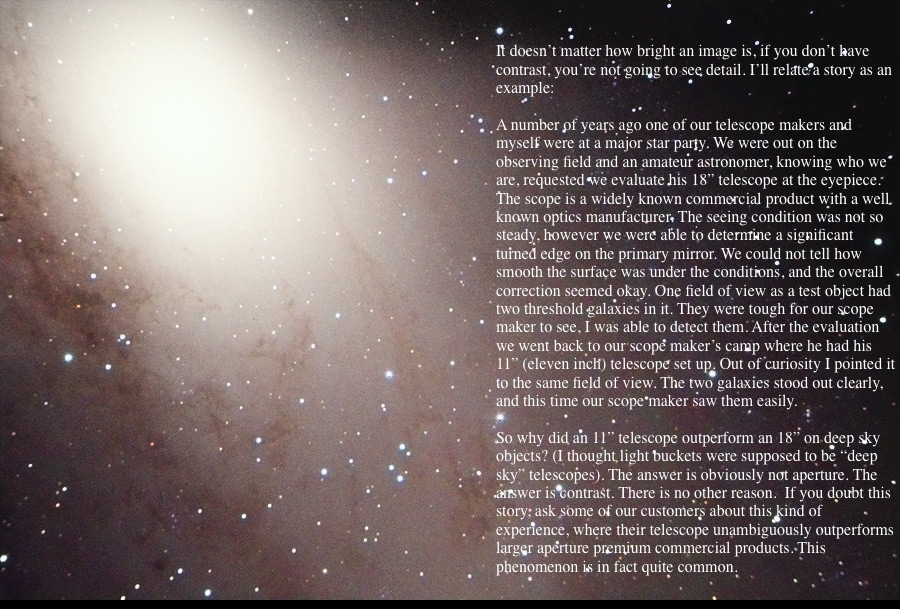 |
||||||
So "Why Zambuto"? In a word, contrast from Wikipedia, There is brightness, which is provided by aperture, and there is contrast, which allows one to see detail. I have been accused of overstating the importance of contrast, so please let me be clear. “Contrast is not everything. Outside of aperture, contrast is the only thing”. -Carl Zambuto |
||||||
Photo is a 12.5" limited edition quartz mirror made as a gift for John Dobson by ZOC |
||||||
 |
||||
Photo is the core of the Andromeda Galaxy taken by Ron Wodaski with a 12.5” Zambuto mirror. Note the spiral dust lanes approaching the edge of the core of the galaxy. Carl Zambuto has seen and noted this phenomenon visually- tracing a dust lane to the edge of the core, through his personal 12.5” telescope. |
||||
Ron Wodaski, author of The New CCD Astronomy and director of www.tzecmaun.org, an internet telescope access site for students and researchers, writes concerning contrast: "Diffraction limited does not equal "perfection". There is no actual diffraction limit per se when it comes to what the eye perceives. The eye thrives on good contrast, and what a high-end mirror (or high-end scope of any kind) provides is improvements in contrast. This allows you to see more detail, since much of the detail on objects like the moon and planets is actually quite low in contrast. If the telescope preserves that contrast to a higher degree, then you will see more detail without necessarily improving actual resolution. As a crude way of explaining this, suppose that you have two areas on Jupiter that are at 48% and 49% brightness (0% being black, 100% being pure white). If your scope lacks sufficient contrast to show that small difference, you will see those two areas as a single feature. For example, if your scope has poor contrast, then it might merge objects visually if they have less than a 5% brightness difference. However, an exceptionally smooth mirror with extremely accurate figure might preserve contrast differences down to fractions of a percent, and you will be able to see detail that is not possible with the poorer optics." |
||
So what you get when you “buy Zambuto” is performance, and what everything finally boils down to is contrast. That is what we specialize in. We offer a primary Newtonian telescope mirror whose contrast capability will not be outperformed. Every effort made in the area of substrate, polish, grind, figure accuracy, edge balance, large scale and microsurface smoothness is geared toward achieving one thing- the highest possible contrast. And when you own a Zambuto mirror, relative to the overall premium telescope market, in cases you’re going to find that you get more than what you pay for. The reason for this is more often than you may expect, you’re going to find your instrument outperforming others of lesser quality, but not necessarily lesser cost. We can say this because when we consider that many premium telescopes being outperformed are larger in aperture, they will likely have greater initial cost, they will be more burdensome to carry around and set up, and so on. So how do we achieve top quality contrast? There are many steps to the process, resulting in seven specific criteria that are met before a Zambuto mirror ships. At the top of this page, click on the link "The Seven Criteria" to find out what's important in achieving this contrast. |
||